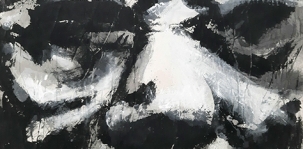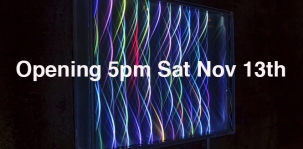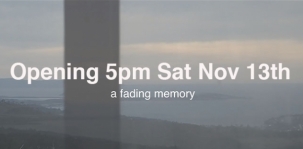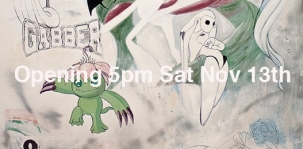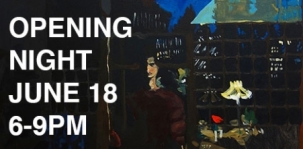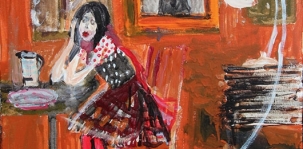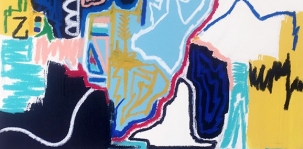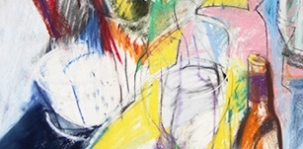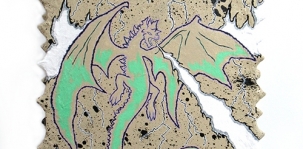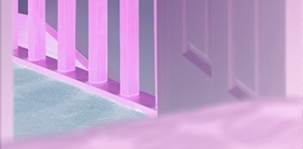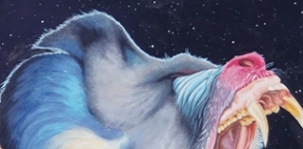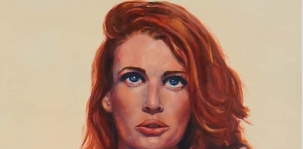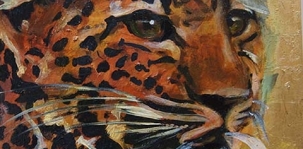Archive : 2021
December 1 - December 18, 2021
Benjamin Uno
The s11 protests were a community response to the World Economic Forum (WEF) held at Crown Casino Melbourne in September 2000. Protesters from a broad demographic picketed the Casino. Their aim was to bring attention to how the WEF helps business develop networks that increase inequality and environmental degradation. Most protesters adhered to the ethos of non-violent civil disobedience. One year later to the day, the World Trade Centre in New York was attacked. This local event was forgotten.
At dawn on the third and final day of the protest, the Labour state government of Steve Bracks ordered a mass-mobilisation of police to break the picket-line by force. The police wore no identification. The protesters were vastly outnumbered and several were injured in the chaos. Bewildered workers on their morning commute were also caught up.
These artworks are driven by an anxiety. I’m trying to work out just what this group of individuals represents. I look into their faces and try and work out what motivated them and how they felt about where they found themselves in that moment. How are these people when in that group? How are they when alone? And then how does that moment represent the bigger picture – the dynamics of Power: how it effects, and is effected?
As in the first iteration of this work 20 years ago, I’ve kept their connection as characters in the Heart Sutra. It is my vain hope, a prayer almost, that underneath or beyond these operations of power, a greater dynamic exists.
In trying to obliterate the likeness and somehow not being able to, in the movement of paint and ink that’s like the inheritance of DNA or the transformation of energy, I’m trying to find out if there is a kind of immortality in portraiture. As it says in the Heart Sutra:
色不異空
空不異色
色即是空
空即是色
Form is not different to emptiness.
Emptiness is not different to form.
Form is indeed emptiness.
Emptiness is indeed form.
November 10 - November 27, 2021
Jasmine Grace
Ebb and Flow; is a series of illusionary light boxes, in constant motion, reflecting the fluctuating nature of life itself and humanity’s ability to embrace its unpredictable nature. This collection embodies the shifting patterns and cycles that enable us to continuously grow and evolve, despite the unforeseen circumstances that come our way. Acting as a reminder that a changing landscape can also be beautiful and luminous. Light and darkness existing together, without one it is hard to value the other. May these pieces bring strength and encouragement to those who own them. LEDs and lenticular layers are used to create 3D effects and visual shifts from various viewing angles. This work transitions through approx. 50 changing colour palettes and can be viewed in both light and dark environments.
Fiona Shewan
Shadow Lines is a photographic and video exploration of the Otago shipwreck that lies on the shores of the Derwent River in Hobart. It is not widely known that this ship was once
captained by Joseph Conrad. It was the last ship he sailed before leaving the marine service and devoting his life to writing. Conrad documents much of his experience as Master of the Otago in his 1915 novel The Shadow Line which is about man’s transition from youth to maturity. This project is concerned with the novel’s relationship to fidelity, given Conrad initially claimed it was autobiographical. The works in this exhibition focus on the discrepancies between Conrad’s representation of the events surrounding the previous captain’s death in the novel and what transpired in real life. Blending imagination with memory, Shadow Lines explores issues concerning identity and truth.
The project is made up of four C-type prints and a series of videos that were composed using Super 8 film, 35mm scans, and digital video. Conrad’s captaincy of the Otago began in 1888 not long after the invention of the steamship which led to a significant shift in maritime culture and production. Blending somewhat obsolete photographic technologies with digital, the work highlights the cultural and spiritual shifts in knowledge brought about by technological developments. While some videos evoke the diary film genre through voiceover, others use subtitles and text to voice transcripts from archival letters regarding the nature of fidelity in Conrad’s novel. Blending the archive with the imaginary, these videos seek to investigate the relationship between spiritual growth, imagination, and fidelity.
Jordan Devlin
“Clues of Chemical Change” seeks to present an individual perspective on the notion of the self and its constant transformation through experiences, stories and technological advancement. Created sporadically throughout the course of the pandemic, the work serves as a vulnerable expression of the artist’s psyche during this unprecedented time.
The work seeks to celebrate the natural disorder involved in both the physical act of painting and the built environment. Mistakes and idiosyncrasies are celebrated as conduits of conversation. The work also considers the relationships between seemingly inanimate and animate objects and their influence on each other. Somewhat familiar characters often appear on a dreamlike plane surrounded by a plethora of shapes and symbols, mirroring the feeling of a lost memory being remembered. The delicate abstract gestures combine with surreal contemporary motifs to reflect an age of fluidity, diversity, unrest and uncertainty. Materials and forms dissolve boundaries to create a singular visual network.
There is a continuous experimentation of techniques and materials in order to more accurately represent the inner and outer worlds surrounding the work. Ultimately, the artist seeks to help create a space for contemplation and exploration of perception, and the personal narratives this may generate.
May 26 - July 3, 2021
May 5 - May 22, 2021
Stephanie Eather
The studio is an intimate thinking box, both sanctuary and workshop — a sandpit of play, a
vessel of inward/outward expansion, a selfsustaining bottle of relations and daydreams, a
Room Of One's Own to explore and make relative; medium, practice and subject. Away from the demands of the omnipresent world, in the studio there remains still a place to be fascinated and the opportunity to dream.
And Then I Dreamt Of Yes - Stephanie Eather presents the studio with movement and lines that refuse to stay still. A directed tumble of erasedback charcoal lines contoured and gliding in snake sizzled drifts of firework impress and pop, hold, skattershake. In Eather’s drawings there is more than the impression of action, there are movements being made and making. We are drawn along eyetrails, entangled with splashes of colour that describe: the side of a wine glass, the edge of a desk or the atemporal slink of shadows over brickwork in her Brunswick studio. Pastel prisms are built up again and again and torn down, their depth and volume recorded in digs and scratches — emotive marks of creation.
Eather shapes a structure, inhabits it’s unseen movement and then breaks it’s outline along imperceptible lines to find a kind of becoming image. A delicate hold on the works time, resolved for a second in frieze, paused inbetween living fresh and cosmetic surgery.
The studio is made live here as means, making and subject. Four walls drawn out enable and
contain volume, mutable and moving, held in space, spilling over — dreamt.
We easily imagine Eather’s dance around the studio as the paper catches her marking and making that extends live and wiggling. Out and beyond these roots and tendrils, we become involved, past the edge of the page, left at that second to wonder — where does Eather’s studio stop?
Logan Ramsay
April 2021
With poetic responses by Logan Ramsay
Michael Kennedy
I have a theory about dragons that I believe is worthy of a PhD, I emailed my alma mater about it but they did not reply. My thesis is that we ideate dinosaurs with their current morphology because we have been imagining dragons for so long, that we simply project these mythical forms onto fossils.
‘Anthropologists force bones together to create these skeletal structures that resemble our
imagination,’ I said, ‘give me a scholarship.’ This is a preoccupation rooted within the early
years of my life, where I would see images of these creatures reproduced on television,
magazines, and urban life.
‘I am contributing to new knowledge by suggesting that dinosaur fossils are a myth and
dragons are a reality,’ my email read. If dinosaurs look like dragons, and dragons look like dinosaurs—a semblance premised on the origins of the first which birthed the appearance of the latter—it means dragons are real.
My aims and objectives was contextualising the work of Michael Kennedy in relation to
dragon theory and object painting. I described how in his exhibition, Ember to Inferno
(2021), Kennedy paints the symbol of the dragon repeatedly with an iconic sensibility to
vacate and refill it with meaning:
‘He customises his canvases to resemble the scaly horns often found in dragon
designs. Then paints these beings with acrylic and minimal lines, evoking the graphic
sensibility of cartoons, street signs, or pop culture shops. However, unlike the clean
lines associated with these visual sites, he creates grungy portraits that bring attention
to the materiality of the object. This is because his paintings are more sculptural than
pictorial.
One of the ways he achieves this is by exhausting the icon of the dragon and
removing it from its referent. This is the nature of the symbol, which points to an
arbitrary meaning—unlike the icon that signifies itself. The image of a dragon
connotes varied ideas such as greed, video gaming, and escapism until Kennedy
repeats it to exhaustion, when it becomes flattened like a sticker and ceases to signify
the form it conveys. This allows the artist to approach the picture as cultural material
in sculptural canvases, that sit closer to an object than an image.
He reinforces this state by incorporating dragon figurines that sit on top or above the frame, creating a relationship of thingness between them.’I explained that my research methodology involves ‘visiting castles around the world with a
stipend,’ while emphasising that ‘I have always wanted to have a picture taken in Versailles
but that’s more of a palace’. Then I suggested that cultures around the world are wrong by
claiming they all share a dragon myth, since these semantics group anything that is large and
serpentine: ‘does a wingless Japanese creature swirling in the ocean really have that much in
common with a European animal hoarding gold like an app developer? I do not think so.’
I returned to Michael’s show to explain why his work looks totally metal, hoping that my
level of rigour would score me an emergency blanket—I mean, scholarship:
‘Since it is impossible to entirely remove the dragon from its connotative chain,
Kennedy continues to reference the metal and gaming subcultures that embrace this
fantastical imagery. The title of the show itself references the debut studio album of
Trivium, a heavy metal band from Florida. This is a motif that extends to the pieces
themselves, with names such as I am death, I am eternal darkness, which is a
reference to Wintersun, a Finnish metal band.
This piece, I am death, I am eternal darkness, is a modified canvas with spiky edges
that Kennedy cyphered with the image of a dragon breathing fire. The outlines are
white in contrast with the black background and mimic the prickliness of the frame.
Its simplicity lends to an abstraction of form, which mirrors the perceptual process
that the artist has undergone by staring, reprocessing, and reimagining dragons for an
extended period. Therefore, the work points to subcultures that exist beyond the artist
—such as metal—while also documenting an inner mental picture.’
I was very pleased with the emotional labour I put into this email so I took a moment to
imagine myself receiving a doctor’s degree, with a few awards. I updated my Tinder bio with
a line that says, ‘Doctorate in Dragonology’ because I believe in manifesting.
Then I clicked send
Dragonology: A Phd Proposal
Diego Ramirez
Ben Kelly
My exhibition is part of an ongoing exploration within my practice of using photography to dissect how a camera sees and how we view images. Through the use of post-capture processes such as printing, scanning, re-photography and collage - sometimes in combination with physical objects such as stickers or biodegradable glitter - I pull images apart and reassemble them, creating new states that question as much as inform the viewer as to what they are looking at.
Photos taken using film, DSLR and smartphone are often a starting point rather than an end product. The repeating motif of windows and views from windows echoes how most images are seen - on a glass screen. Mostly landscape based, they exist free of time and place; some images taken as recently as this month and others taken more than 10 years ago. They could be anywhere; sometimes feeling very familiar, sometimes quite foreign.
While heavily photographic in nature and process, I try to create works that don’t rely on an inherent knowledge of photographic production and history to derive meaning; they can be enjoyed equally whether by a member of the public or by a professional photographer.
April 14 - May 1, 2021
Michelle Giblett & Michelle Hunt
'With the sun on our backs and the wind at our heels' features a body of recent work by Michelle Hunt and Michelle Giblett. The exhibition offers reflections on being a woman via dreams and the elaboration of them into a personal symbology and mythology. As suggested by the title the tone of these artworks is one of positivity and optimism during difficult times.
Michelle Hunt & Michelle Giblett
'With the sun on our backs and the wind at our heels' features a body of recent work by Michelle Hunt and Michelle Giblett. The exhibition offers reflections on being a woman via dreams and the elaboration of them into a personal symbology and mythology. As suggested by the title the tone of these artworks is one of positivity and optimism during difficult times.
Michelle Hunt & Michelle Giblett
'With the sun on our backs and the wind at our heels' features a body of recent work by Michelle Hunt and Michelle Giblett. The exhibition offers reflections on being a woman via dreams and the elaboration of them into a personal symbology and mythology. As suggested by the title the tone of these artworks is one of positivity and optimism during difficult times.
